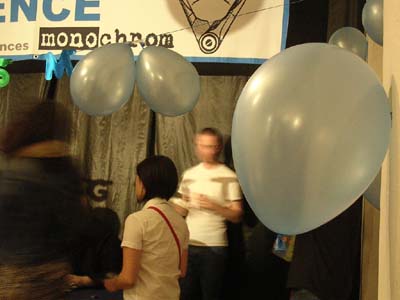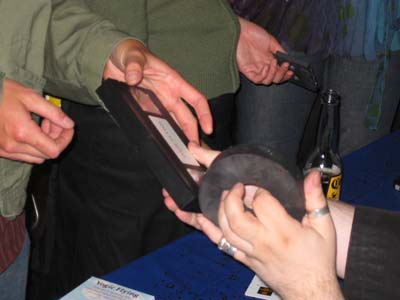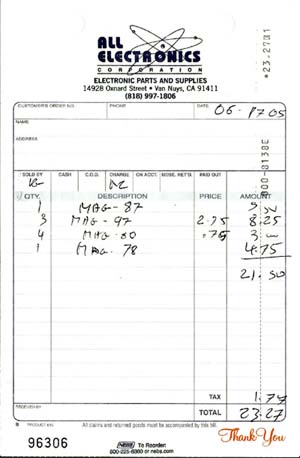|


The Experiences
Experience The Experience Of Being
Buried Alive (June 14/8 PM: Los
Angeles, June 30/8 PM: Vancouver, July 8/7 PM: San Francisco)
Experience
The Experience Of An Illegal Space Race
(June 25/ 2 PM: Los Angeles)
Experience
The Experience Of Growing Money
(July 14/ 8 PM: San Francisco)
Experience
The Experience Of A Magnetism Party
(June 18/8 PM, Los Angeles)
Experience The Experience Of Catapulting Wireless
Devices (Workshop: July 9/6 PM; Event: July 16/2 PM, San Francisco)
Experience The Experience Of A Brick Of Coke
(June 21/8 PM: Los Angeles)
Experience The Experience Of 1 Baud
(Workshop: July 20/6 PM; Event: July 22/5 PM: San Francisco) |
|
|
Experience The Experience Of A Magnetism Party
|
Combining the benefits of a bad college party with the primal fear of the information age: data loss.
Electromagnetic data carriers are subject to the influences of time. Errors thus accumulate, due to mechanical influences, chemical influences, thermic influences, influences from external magnetic fields. The data carriers age, and the information stored on them is affected. The bits can no longer be read, or they are altered, or the information is lost. Accompanied by contemporary alternative mainstream rhythms and using several heavy-duty neodym magnets, monochrom will delete all the data carriers that can be found. Naturally the public is invited to bring data carriers themselves. The destruction of magnetic storage media is a form of destruction that can reasonably be called unspectacular. But it is important. Our society collects and collects and collects. The hard drives are full. However, we can also dispense with the bourgeois-humanist criticism of the "information flood", this maelstrom that is said to attack the printed word. The Magnetism Party is therefore an attempt to actively come to terms with one aspect of the information society that is almost completely ignored by our epistemological machinery. Delete is just another word for nothing left to lose.
Los Angeles (Machine Project): June 18, 8 PM.
|
June 23.
'Der Spiegel', 'Der Stern' and 'N24' publish short German-language articles about "Experience The Experience Of A Magnetism Party".
Der Spiegel / Link
Der Stern / Link
N24 / Link
[posted by johannes at
11:37 AM]
Bring your friends! And data. We'll do the rest.
June 18. Evening.
A delete parade, a fete for the faded, for the yellowed! For the many little zeroes that dance behind red android eyes in lousy cyberpunk B movies! A party for bringing about and celebrating the loss of cultural memory.
Iron shavings, taco chips and drinks are available.
The MCs can hardly wait.
But first... the opening talk.

Before we inform the public about the magnetic act of purification we briefly deal with the so-called 'Magnetic Media Layer'.

The Magnetic Media Layer is a very thin coating of magnetic material on a magnetic data disk drive which is where the actual data is stored; it is typically only a few millionths of an inch in thickness.
Older hard disks used oxide media. "Oxide" really means iron oxide--rust. Of course no high-tech company wants to say they use rust in their products, so they instead say something like "high-performance oxide media layer". But in fact, that's basically what oxide media is, particles of rust attached to the surface of the platter substrate using a binding agent. You can actually see this if you look at the surface of an older hard disk platter: it has the characteristic light brown color. This type of media is similar to what is used in audio cassette tape (which has a similar color.)
Oxide media is inexpensive to use, but also has several important shortcomings. The first is that it is a soft material, and easily damaged from contact by a read/write head. The second is that it is only useful for relatively low-density storage. It worked fine for older hard disks with relatively low data density, but as manufacturers sought to pack more and more data into the same space, oxide was not up to the task: the oxide particles became too large for the small magnetic fields of newer designs.
Today's hard disks use thin film media. As the name suggests, thin film media consists of a very thin layer of magnetic material applied to the surface of the platters. (While oxide media certainly isn't thick by any reasonable use of the word, it was much thicker than this new media material; hence the name "thin film".) Special manufacturing techniques are employed to deposit the media material on the platters. One method is electroplating, which deposits the material on the platters using a process similar to that used in electroplating jewelry. Another is sputtering, which uses a vapor-deposition process borrowed from the manufacture of semiconductors to deposit an extremely thin layer of magnetic material on the surface. Sputtered platters have the advantage of a more uniform and flat surface than plating. Due to the increased need for high quality on newer drives, sputtering is the primary method used on new disk drives, despite its higher cost.
Compared to oxide media, thin film media is much more uniform and smooth. It also has greatly superior magnetic properties, allowing it to hold much more data in the same amount of space. Finally, it's a much harder and more durable material than oxide, and therefore much less susceptible to damage.
After applying the magnetic media, the surface of each platter is usually covered with a thin, protective, layer made of carbon. On top of this, a super-thin lubricating layer is added. These material are used to protect the disk from damage caused by accidental contact from the heads or other foreign matter that might get into the drive. 
Our hard disks are full!

Field intensity H! Flux density B!

Pleasant hours of erasure, iron filings, and peer-groupesque Corona consumption.

The vibes are very engaging.

Injuries caused by accidents with strong magnets: 1.

We are almost unable to cope with the rush...

...but the old bogeyman of the information society should be finally given a good disregarding.

Successful procedures:13 3 1/2 inch disks
1 5 1/4 inch disk
1 audio cassette
2 VHS tapes
8 ZIP disks
1 hard drive (1 GB)
1 Los Angeles Public Library card
1 Comfort Inn room keycard
3 California drivers licenses
1 Nevada drivers license
...and...  1 iPod (40 gig) 
Immediate results.
A magnet a day keeps the iPod away.

The Magnetism Party 2005:
A significant success.
(Pictures by Jason, Sean and Johannes.)
[posted by johannes at
11:44 AM]
Final Preparations
June 18. Afternoon.




The time has come.
[posted by johannes at
10:06 AM]
Music?
June 18. Midday.
We start selecting music for the evening.
Some examples:
Matthias Kertal: Alles Verloren (Lost Everything / Life Goes On)
Vibemaster: Eine Bewegung (A Movement)
TNT Jackson: Ratterbit
[posted by johannes at
11:58 AM]
Party store
June 17. Morning.
Evelyn, Mark and Johannes buy party stuff.




Neodymium iron boron (NdFeB) magnets have the highest magnetic field strength, but are inferior to samarium cobalt in resistance to oxidation and temperature. This type of magnet is expensive, due to both the cost of raw materials and licensing of the patents involved. This high cost limits their use to applications where such high strengths from a compact magnet are critical. Use of protective surface treatments such as gold, nickel, zinc and tin plating and epoxy resin coating can provide corrosion and thermal protection where required.

[posted by johannes at
12:51 PM]
Party off!
June 16:
Two more days...

[posted by johannes at
10:25 AM]
Respect! Respect! Oersted!
Electromagnetic data carriers are subject to the influences of time. Thus errors accumulate due to
a) mechanical influences,
b) chemical influences,
c) thermal influences,
d) influences of external magnetic fields.
Information is affected by the fact that data carriers age. Bits can no longer be read or they may be altered, and thus the information is lost. Correct handling and storage are the basic requirements for keeping your data carriers in good condition. Improper handling may produce scratches and therefore mechanical damage of the data carrier. The data carrier must be protected from dust and other contamination. Even fingerprints left on data media are to be avoided. Here the most important chemical processes are corrosion and hydrolysis. High temperatures will cause the data carrier to expand. Due to rotational instability, errors may thus occur in the reading process. Moreover, high temperatures will aggravate the chemical processes mentioned above. With regard to magnetic storage, data may even be deleted directly by very high temperatures (above 250 degrees C). The same may happen if the data carrier is exposed to magnetic fields.
Perfect.

The Magnetism Party 2005 @ Machine Project will take place on 18 June 2005, starting at 8 PM.
The motto is 'Zeroize it! Hardcore gaussing!' and the user-friendly team of the disposition group monochrom will delete your data utilising several strong neodym magnets and some not so strong bar magnets while listening to timely underground mainstream rhythms. Hand over your video tapes, music records, credit cards, motherboards and/or jazz/zip/syquest data carriers!

The destruction of magnetic data media is a type of destruction one may well call unspectacular. However. It is correct anyway.
Our society gathers, collects and amasses. Our hard disks are full.
But the bourgeois-humanist critique 'the informational flood', this maelstrom that seems to attack the printed word, may kiss our Baudrillardian asses. All the lamenting about the net being a threat to high culture is as alien to us as Whiskas to Marshall McLuhan. Our project is more of an attempt to actively deal with an aspect of info society which is almost completely ignored by our cognitive machinery.
'We want to give it an image more positive than the pathogenous. We refuse to regard as experienceable only that part of life which is expressible, explainable, and instrumentalisable. We refuse to accept oblivion as the appendix of memory,' said Herwig Turk once. Let us write this on our magnets!
Today it is impossible to store digital data for over a decade so that its readability is guaranteed. This is mainly due to the quick development of hard- and software and thus the rapid obsolescence of data systems. However, the physical durability of data carriers operated by current technologies also restricts the service life of digital data to a few decades. According to information technology, 60% of the landing on the moon never happened. Most of the magnetic tapes from the 60s and early 70s have already been damaged and can no longer be read. This also effects data which has not even been analysed. Good!

Delete is just another word for nothing left to lose.
[posted by johannes at
9:33 AM]
Experience The Experience Of A Magnetism Party

[posted by johannes at
11:08 AM]
|